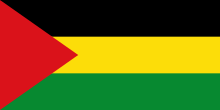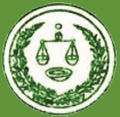Benishangul-Gumuz Region
Benishangul-Gumuz (Amharic: ቤንሻንጉል ጉሙዝ, romanized: Benšangul Gumuz), also known as Benshangul/Gumuz, is one of the ten regional states (kililoch) of Ethiopia. It was previously known as Region 6. The region's capital is Assosa. Following the adoption of the 1995 constitution, the Region was created from the westernmost portion of the Gojjam province (the part north of the Abay River), and the northwestern portion of the Welega Province (the part south of the Abay). The name of the region comes from two local ethnic groups – Berta (also called as Benishangul) and Gumuz.
Benishangul-Gumuz Region ቤንሻንጉል ጉሙዝ | |
|---|---|
 Flag  Seal | |
 Map of Ethiopia showing Benishangul-Gumuz Region | |
| Country | Ethiopia |
| Capital | Asosa |
| Government | |
| Area | |
| • Total | 50,699 km2 (19,575 sq mi) |
| [1] | |
| Population (2018) | |
| • Total | 1,127,001[2] |
| ISO 3166 code | ET-BE |
| HDI (2017) | 0.453[3] low · 7th |
The region has faced major challenges to economic development, due to lack of transportation and communications infrastructure. The Abay River (Blue Nile) divides Benishangul-Gumuz, and there was no bridge crossing it until 2012. The major road that connects the Metekel Zone and the Asosa Zone was built by the China Construction Company in 2012. The road has a 365-meter bridge that crosses the Abay. Nowadays it is simple to travel between the regional capital of Assosa and Gilgil Beles, the capital of the Metekel Zone. Previously one had to travel through Wollega and Gojjam in the neighboring regions of Oromia and Amhara, a distance of 1,250 kilometers, but it is now around 378 kilometers on the new road and bridge. Conditions for travel within zones varies, but is often poor and subject to disruption by the rainy season.[4] On 28 July 2009, the Regional Rural Roads Authority reported that over the previous year almost 600 of the 800 kilometers of local all-weather roads had been upgraded at a cost of 11.5 million birr, and an additional 447 kilometers of roads constructed.
Demographics
Based on the 2007 Census conducted by the Central Statistical Agency of Ethiopia (CSA), the Benishangul-Gumuz Region has a total population of 784,345, consisting of 398,655 men and 385,690 women; urban inhabitants number 105,926 or 13.51% of the population. With an estimated area of 49,289.46 square kilometers, this Region has an estimated density of 15.91 people per square kilometer. For the entire region 174,445 households were counted, which results in an average for the Region of 4.5 persons to a household, with urban households having on average 3.6 and rural households 4.7 people. The ethnic groups include the Amhara (25.41%), Berta (21.69%),, Oromo (13.55%), Shinasha (7.73%) and Agaw-Awi (4.22%). Main languages are the Berta(25.15%), Amharic (22.46%), Gumuz (20.59%), Oromo (17.69%), Shinasha (4.58%) and Awngi(4.01%). Concerning religion, 44.7% were Orthodox Christians, 33.3% Muslim, 13.53% were Protestant, and 7.09% practiced traditional beliefs. It had a projected population of 1,127,001 in 2018.
In the previous census, conducted in 1994, the Region's population was reported to be 460,459 of which 233,013 were men and 227,446 were women. Rural population was 424,432, while the urban population was 36,027.
According to the CSA, as of 2004, 27.23% of the total population had access to safe drinking water, of whom 22.35% were rural inhabitants and 58.53% were urban.[5] Values for other reported common indicators of the standard of living for Benishangul-Gumuz as of 2005 include the following: 19.1% of the inhabitants fall into the lowest wealth quintile; adult literacy for men is 47.4% and for women 23.2%; and the Regional infant mortality rate is 84 infant deaths per 1,000 live births, which is greater than the nationwide average of 77; at least half of these deaths occurred in the infants’ first month of life.[6]
There are 2 refugee camps and 1 transit center, housing 36,440 refugees from Sudan and South Sudan, located in Benishangul-Gumuz Region.[7]
Ethnic groups
Some major ethnic groups native to the Benishangul-Gumuz Region are:
- Nilo-Saharan
- Berta, mostly in Asosa Zone
- Kwama, mostly in Mao-Komo special woreda
- Omotic
- Shinasha, mostly in Metekel Zone
- Mao, mostly in Mao-Komo special woreda
- Bambasi, mostly in Bambasi (woreda)
Agriculture
The CSA of Ethiopia estimated in 2005 that farmers in Benishangul-Gumuz had a total of 307,820 head of cattle (representing 0.79% of Ethiopia's total cattle), 65,800 sheep (0.38%), 244,570 goats (1.88%), 1,770 mules (1.2%), 37,520 asses (1.5%), 732,270 poultry of all species (2.37%), and 166,130 beehives (3.82%).[8]
Over 60% of this Region is covered with forest, including bamboo, eucalyptus and rubber trees, incense and gum forests as well as the indengenous species. However, due to increased population which has led to the widespread destruction of the canopy, authorities announced a campaign on 8 June 2007 to plant 1.5 million seedlings over the next two months to replenish this resource.[9]
Presidents of the Executive Committee
- Attom Mustapha (BPLM) after 1991
- Abdu Mohammad Ali (BPLM) 1990s
- Ateyb Ahmed (BPLM) 1990s - 1995
- Yaregal Aysheshum (B-GPDUF) July 1995 - November 2008
- Ahmed Nasir Ahmed (B-GPDUF) November 2008 - May 2016
- Ashadli Hasen (B-BGDP) June 2016 – present
(This list is based on information from Worldstatesmen.org, John Young,[10] and the Ethiopian News Agency website[11])
Administrative zones
Like other Regions in Ethiopia, Benishangul-Gumuz is subdivided into administrative zones.
Notes
- 2011 National Statistics Archived March 30, 2013, at the Wayback Machine
- Population Projection of Ethiopia for All Regions At Wereda Level from 2014 – 2017. Federal Democratic Republic of Ethiopia Central Statistical Agency. Archived from the original on 6 June 2018. Retrieved 4 June 2018.
- "Sub-national HDI - Area Database - Global Data Lab". hdi.globaldatalab.org. Retrieved 2018-09-13.
- John Young "Along Ethiopia's Western Frontier: Gambella and Benishangul in Transition", Journal of Modern African Studies, 37 (1999), p. 342
- "Households by sources of drinking water, safe water sources" Archived March 5, 2009, at the Wayback Machine CSA Selected Basic Welfare Indicators (accessed 28 January 2009)
- Macro International Inc. "2008. Ethiopia Atlas of Key Demographic and Health Indicators, 2005." (Calverton: Macro International, 2008), pp. 2, 3, 10 (accessed 28 January 2009)
- "Archived copy". Archived from the original on 2012-01-17. Retrieved 2012-05-23.CS1 maint: archived copy as title (link), The UN Refugee Agency website
- "CSA 2005 National Statistics" Archived November 18, 2008, at the Wayback Machine, Tables D.4 - D.7.
- Ethiopia: Tackling environmental challenges with trees (IRIN)
- "Along Ethiopia's Western Frontier", p. 334
- "Benishangul Gumuz State Council appoints Ahmed Nasir as chief of state", Ethiopian News Agency, 4 November 2008
External links
- Map of Benishangul-Gumuz Region at UN-OCHA
- Map of Benishangul-Gumuz Region at DPPA of Ethiopia
- House of Federation Official Ethiopian Government List of Members